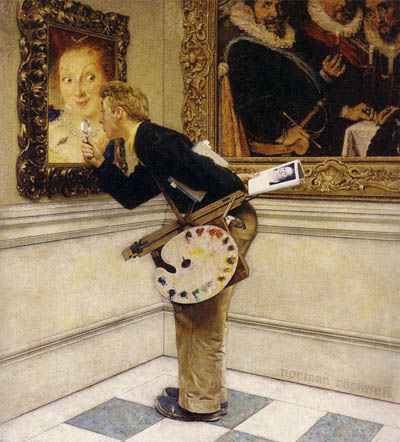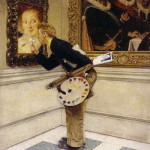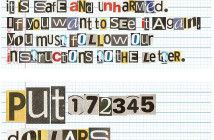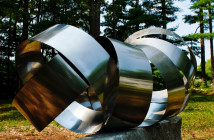THE DISAPPEARING CRITIC
We are living in the great age of opinion-writing, of critiques and commentaries, so why are so many of the art critics disappearing from major metropolitan newspapers? (Hint: It’s not just fine arts but book and performing arts critics as well.) Perhaps more importantly, what does this mean for artists looking to advance their careers?
For most of the postwar era, and even before that, critics have acted as the conduit between artists and the general public, and artists have relied on reviews to generate discussion of, and interest in, their work. Sometimes, that has led to contentious relationships between artists and critics, but even an unfavorable review produces awareness. As the songwriter George M. Cohan reportedly said, “I don't care what you say about me, as long as you say something about me, and as long as you spell my name right.”
These days, a lot less is being said. Regional newspapers that used to have full-time art critics - such as, The Boston Globe, Hartford Courant, Philadelphia Inquirer and even The Wall Street Journal - no longer do, and the jobs of writers who were hired originally as critics have morphed into general assignment feature writers who may get to do an occasional review. “I was hired as an art critic, but I’m increasingly doing other things, some of which have nothing to do with art,” said David Bonetti of the St. Louis Post-Dispatch, who still refers to himself as “the only salaried art critic in St. Louis.” Fighting with his employers for the job he was originally hired to do “would not be to my advantage.”
Other newspaper writers tell the same story. “I write about the visual arts but, if I’m writing about an exhibition at a museum or gallery, I’m not talking about the show curatorially or aesthetically,” said Jonathan Marx, who once reviewed but now just reports on the fine arts for the Nashville-based Tennessean. “If I express opinions, they have to be quotes from different people.” Sara Pearce, once the designated art critic and now a features writer for the Cincinnati Enquirer, is permitted to offer opinions about art, but only on her blog on the newspaper’s Web site. “I’m certainly critical there, and I say a lot of things, but otherwise I’m a reporter, covering architecture and books, as well as the arts.” She added that “no one really does art criticism here anymore.”
The declining number of newspaper art critics alarms Eleanor Heartney, a past president of the United States section of the International Association of Art Critics, who described “a trend in publications away from substance. Artists are treated as entertainment.” However, Sara Pearce’s job-downgrading does not reflect an antipathy to the arts, according to her boss, William Cieslewicz, assistant managing editor for features at the Enquirer. That newspaper and most others across the country are losing readership and advertising revenues, resulting in staff cutbacks. “Full-time critics are viewed as a luxury,” he said. “The only critic we have left is our dining critic, but there has been discussion about keeping that.” The Enquirer still encourages airing reviews of arts and other cultural events, he noted, through the newspaper’s Web site, where readers are “invited to post their opinions on what’s going on locally. Most of these reader reviews are for restaurants and movies.”
However, the lack of art reviews hasn’t had an adverse effect on museum and gallery attendance in Cincinnati, nor on sales, according to several art dealers there. “Our business is very active and good,” said gallery owner Carl Solway, attributing the growth in sales to new buyers that are met at the art fairs he attends as an exhibitor in Chicago and New York City. Business is also good at the Phyllis Weston-Annie Bolling Gallery, even though “we haven’t gotten a print review for over a year,” according to gallery director Kate Yellig. The Malton Gallery is only “doing OK,” said its owner Sylvia Rombis, who ascribed lackluster sales to the state of the economy and the gallery’s difficulty in expanding its buyer base to younger collectors. “To have a viable section in the paper where you could read an intellectual discussion about art would be awesome,” she said. Still, that might not solve all her problems, because “younger customers aren’t newspaper readers anyway.”
Certainly, the disappearing newspaper critic has made the job of promoting artists and their exhibitions much more difficult, leading to different strategies. Shannon Wilkinson, president of Cultural Communications, a New York City-based public relations company specializing in the arts, noted that newspaper executives have found “the level of art advertising is too low to merit paying critics’ salaries.” She recommended advertising in newspapers and magazines, because advertisers “are more likely to get reviewed, although that’s not a guarantee.” She also stated that arranging an exhibition overseas, particularly Europe where the major newspapers still have salaried critics, is a way of obtaining critical attention, and “writers in the U.S. pay more attention to artists who have been written up in Europe.”
The experience in Cincinnati demonstrates that galleries don’t necessarily require reviews to promote their exhibits to the public and have strong sales. Perhaps, it also reveals that individual artists may not need critics to validate their careers either. Artists often stockpile reviews, which are placed in media kits that are mailed to editors and writers at newspapers and magazines in advance of an exhibition. The kits usually contain a brief biography (in narrative or resume form), images of their work (slides, photographs or a CD-ROM), occasionally an artist statement (noting sources of inspiration, the technical process involved in the artmaking, artistic influences or past projects), as well as past reviews and feature articles about the artist. These reviews and articles are important both to editors, want to know that the artist has been deemed worthy to be written about in the past, and to writers, want to know what others have said. Media kits still have their place, but in the new world of declining newspaper readership and growing use of the Internet as a primary source of information, artists, galleries and museums are also finding different, increasingly online, ways to promote themselves to journalists, collectors and the general public. “We’re a 100 percent online company, “said Christina Duren, publicity director of New York City’s Ariel Publicity Artist Relations. “We work with bloggers, Webzines, pod casts and Internet radio stations to get reviews and interviews for the artists we represent.”
Marketing to the Internet, she noted, has proven successful in various realms of the arts, adding that correlations have been found between popular music albums that are mentioned in numerous blogs and increased sales of these recordings, as well as the fact that heavily blogged news stories are more likely to air on the evening news. One blog can be linked by another, which increases the likelihood that their content will be visited and read. Some blog writers have greater influence than others, which can be charted by how many links are made to that site. “It’s a very good idea to promote yourself to bloggers selectively and strategically, depending on what you are trying to engage them with,” said Sasha Freudenheim, vice-president of the Manhattan-based Resnicow Schroeder Associates, a public relations agency that works with many museums. “Bloggers seed the attention of the mainstream journalists,” which may lead to reviews, articles or other coverage.
A first step to find the most appropriate bloggers is using a blogging directory, of which there are many (blogsearchengine.com, bloghub.com, blogsearch.google.com, bloggeries.com, among others – one of the more all-encompassing sources is Yahoo Blog Directories). Bloggers usually offer an email address for responses, and artists may contact them informally, inquiring if they would be interested in receiving information on the artist or upcoming exhibition or new project or anything else. They may also attach a press release or link to the artist’s own Web site.
Joan Stewart, a publicist in Port Washington, Wisconsin, also recommended that artists create their own blogs and add comments in the Forum sections of artists association Web sites, all as a way of increasing the opportunity for their names and sites to come up in an online search. “Nine out of 10 journalists do their research online,” she said, adding that more and more collectors learn about artists not just by reading print reviews or feature articles but by making a search using an Internet search engine, such as Google or Yahoo! In this new world, artists may get their work looked at and talked about without necessarily having a gallery exhibition – or through creating a “virtual” exhibit – by posting images online on their own Web sites, linking them to other sites and even making a video of themselves at work (or just of their work) and posting that on YouTube or other video-sharing sites. “People love videos, search engines love videos,” she said. “You’ll love that you can post it for free.”
- Norman Rockwell, Art Critic, Oil on canvas, 1955. Cover for The Saturday Evening Post, April 16, 1955. (Courtesy of The Norman Rockwell Museum).
Image courtesy of The Norman Rockwell Museum, via Google.





